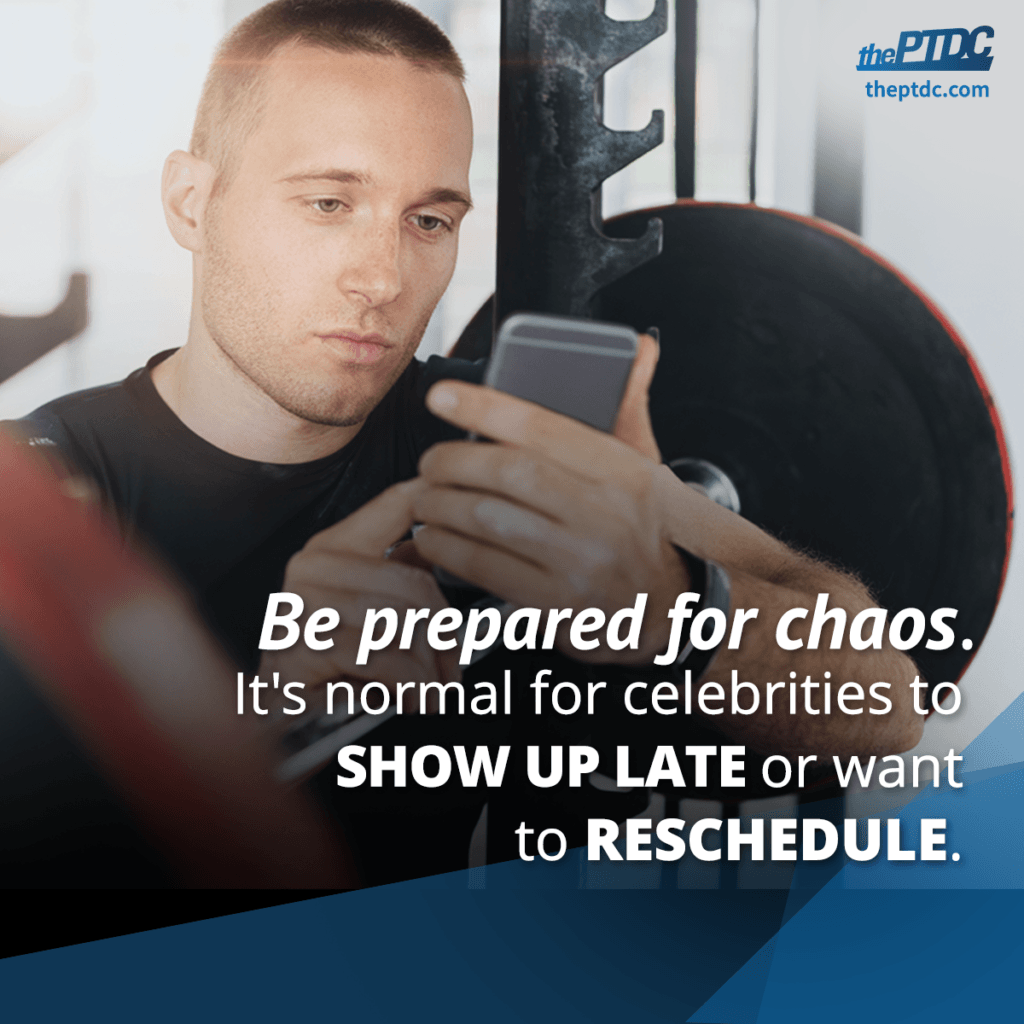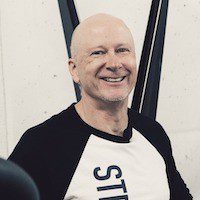There’s an old rule about success: You have to be before you can do, and you have to do before you can have.
Personal trainers understand it intuitively; it’s hard to act like you know your way around the gym if you don’t. That’s why so many successful trainers start out as athletes and gym rats, and more often than not look like it.
But those who successfully train famous people develop qualities that go far beyond their appearance, knowledge, and experience.
If you’ve ever thought about working with celebrities—whether they’re superstars who’d be recognized anywhere in the world or a local newscaster who’s just famous enough to get a sideways glance in Safeway—here are five key factors that you’ll need to consider.
1. Be Visible
I’ve known Chad Waterbury, DPT, since 2005. Back then, he was still living in Tucson, where he’d gotten his master’s degree at the University of Arizona. But he was planning to move to Los Angeles—in part, he told me, because he wanted to work with A-list clients.
Today, after 11 years in L.A., he’s trained a long list of them, ranging from elite athletes to mostly forgotten reality stars. It all started with proximity. “This is the most important tip I would give anyone,” he says. “You have to get yourself, physically, around the people you want to work with.”
Waterbury first learned this lesson in the ’90s, when he did an internship at the gym in Chicago where legendary strength coach Tim Grover trained NBA stars like Michael Jordan.
“At that time, being a huge Bulls fan, I thought that was the best place to go, and he was the best person I could be around,” he says. Although they never worked together directly, he got to observe Grover working with his all-star clients, taking note of how he interacted with them.

At the end of the internship, he says, Grover told him he was on the right path and predicted he’d do well in the fitness industry. “It was like being a computer programmer and getting a pat on the back from Bill Gates,” he remembers.
Location, Location, Location
There’s more than one way to be visible, as Chad Landers discovered in 2003. After working as a personal trainer in L.A. for 10 years, he opened Push Private Fitness in the Toluca Lake neighborhood. Not only do a lot of entertainers live nearby, his gym is in the heart of the industry itself. Disney, Warner Bros., CBS, and NBC Universal all have studios within a couple of miles.
“It wasn’t like I set out to train celebrities,” he says. “But being in a good location set me up for that. Once I got somebody from the area, they started referring me to their friends.”
Like Waterbury, he’s trained a lot of famous people, few of whom he can talk about on the record. (More on that in a moment.) Unlike Waterbury, though, his entertainment-industry clients tend to be “working” actors and musicians. “It’s like, they were on a show, and now they’re between shows, but they still need to look good so they can get the next one,” he says.
And sometimes they have to look really good, really fast. Which brings us to the next point.
2. Be Ready for Anything
Imagine this conversation with a client:
“I need to lose 30 pounds.”
“Okay. How much time do we have?”
“Three weeks.”
Crazy? Sure. But when you train actors, it’s part of the deal. In this case, Landers’ client had shot a pilot for a TV series years before. When the series was unexpectedly green-lighted, the actor learned he had less than a month to lose the weight he’d gained in the interim.
They used a protein-sparing modified fast to take the weight off. “I don’t want to have to do things like I did with him,” Landers says. “They were happy with the way he looked, but it was a little bit unhealthy.”
And that’s not even his most extreme example. Landers was training Corbin Bleu, an actor who at the time was best-known for the three High School Musical movies. He’d been cast in a horror movie that included a nude scene, calling for a level of leanness that few trainers outside the world of physique competition ever have to worry about.
Landers helped him drop 14 pounds, getting him lean but not ripped. For the final push, they used what Landers calls the “crazy bath,” which I described in this article in 2013.
The night before Bleu shot the nude scene, they filled a tub with the hottest water a human can tolerate, along with three or four bags of Epson salt and four to six bottles of rubbing alcohol. Bleu sat in the bath as long as he could tolerate it. (He told me it felt “like hell.”)
The goal was to lose as much water as possible without risking his health, and it worked: Bleu lost seven pounds overnight, got shredded for the scene, and suffered no consequences from the short-term dehydration.

Those two examples certainly aren’t typical, but they illustrate one of the challenges of working with clients whose livelihood is so entwined with their appearance. Most working actors go through boom-and-bust cycles, Landers says. Even successful ones get cash-strapped between roles.
“I’ve had situations where they had to stop training until they could book something,” Landers says. “But it’s a catch-22, because they have to look good to book something. When they have the time to come in, they don’t have the money. When they have the money, they don’t have the time.”
3. Be Discreet
I have a friend who works almost exclusively with celebrities. It’s no secret; you can’t miss them on his social media, where they sometimes demonstrate exercises for quasi-instructional videos. But he didn’t want to be interviewed for this story because he doesn’t want his famous clients to think he’s taking advantage of his association with them.
Waterbury didn’t want to talk about any of the celebrities he’s trained, even though we coauthored a book with one of them.
And Landers can only talk about a few of his well-known clients, including Bleu, Duff McKagan from Guns N’ Roses, and actress Sarah Hyland from Modern Family.
But even if he could talk about the most famous ones, he wouldn’t necessarily want to. “If I started promoting that I train this person or that person, the paparazzi would be here all the time,” he says. “I don’t mind that people don’t know all the people I train. It’s not about me, and that’s okay.”
4. Be Pleasant
Most of the people I know who train celebrities didn’t grow up in big cities. Waterbury and Landers, coincidentally, are both from small towns in Illinois, where being nice to people is the norm. Turns out, those small-town manners are an important tool if you want to work with famous clients.
No matter where you’re from, Waterbury believes How to Win Friends and Influence People is the most important book for trainers in his line of work. “You can’t be an asshole, or a nutcase,” he says. “You have to be someone you’d want to hang around.”
You still have to push those clients, some more than others. But in Waterbury’s experience, the more famous people become, and the more pressure they face to produce hits and make money for them and their partners, the less bandwidth they have for cynicism and snark. “Celebrities never have negative people around them,” he says, “especially here in L.A.”
5. Be Flexible
Over the years I’ve interviewed a handful of celebrities for Men’s Health magazine, usually because they’d transformed their physiques for a particular role. That means I also interviewed their trainers, who told me stories of traveling thousands of miles to help their clients prep for a shirtless scene, or stay in shape for physically demanding roles.
It’s the last thing most trainers would think about when they get a chance to work with a celebrity, but with some clients it’s the most important part of the job. If you don’t do it, someone else will, and guess who’s going to take credit for the client’s physique?

But it’s not just travel. There’s also the day-to-day chaos of a famous person’s life. Here’s how one trainer, who asked not to be quoted by name, explained it to me:
“If you want to work with celebrities, the number-one hardest thing, by far, is scheduling. It’s normal for them to show up late and still want their one-hour session. Or they’ll want to reschedule. The trainer is used to a structured world, but now he has to step into the celebrity’s world and deal with the chaos. You just couldn’t stack eight celebrity clients in a day. I can’t work with more than three a day. It’s too stressful.”
The one bright spot, the trainer told me, is that you can charge them more. Sometimes a lot more. But then again, if they didn’t pay you more you’d lose money because of all the clients you can’t train while you accommodate the celebrities’ chaotic schedule.
Bonus Tip: Treat Everyone Like a Celebrity
“I don’t call myself a celebrity trainer, and I didn’t set out to train celebrities,” Landers says. “I’m training anyone who walks in the door and who’s willing to put in the work. It doesn’t matter if they’re a celebrity or an average person. Except the average person isn’t going to have to do a nude scene, or be naked on a billboard.”
There’s the rub for trainers who work with famous people, whether it’s something they set out to do or something that just kind of happened. You have to treat everyone the same, even though some will demand more of your time and attention than others.
“I’m not going to say it’s not cool to work with famous people,” Landers says. “But at the end of the day, there are two people whose stories I share.”
One is an elderly woman who started training with him in her late 80s. By the time she passed away in her mid 90s, she was still able to get up and move around on her own.
The other is Barbara Garmon, who became a world-champion powerlifter in her 70s, after surviving cancer and a freak accident that shattered her left arm. Her extraordinary story was told in this article, which blurs the lines between his famous and non-famous clients.
When a trainer helps an “average” person do something worth celebrating, is there really that much difference?










